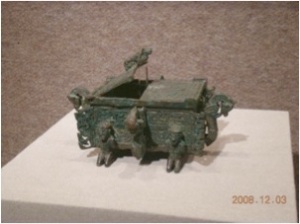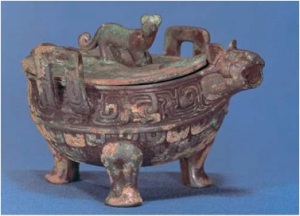The problem of determining ethnicity part 2: Fu Hao 妇好 and the Jin 晋 consorts at Beizhao
April 22, 2011 § Leave a comment
The case of male tomb M54 is unusual because most tomb occupants who are thought to be of different ethnic origins to the Shang and Zhou are female. The assumption is that the Shang and Zhou elites married these females to consolidate power or to build ties with neighboring states or groups. As with tomb M54, the theoretical position of scholars who maintain that a female might be foreign rests on the presence of foreign objects inside the grave, and that these objects denoted the tomb occupant’s ethnicity.
In the Late Shang, royal consort Fu Hao (whose tomb was excavated in the late 1970’s) is commonly regarded as an outsider, as the tomb contained a number of foreign objects such as bronze mirrors, knives, bow-shaped objects and horse fittings (two bridles).
In the Zhou, several of the consorts to the Jin state lineage heads are also thought to have been from the Northern Zone. Tomb M113 (at the site of Beizhao) contained two bronze vessels which appear to have been modelled after ceramic pottery types found in the north.

A few of the Jin consort tombs also contained ornate and very unusual miniature bronze boxes (about 10cm long and 6cm high).
The exact function of these small bronze pieces is unknown (one idea is that they served as jewelery containers – in reality this seem unlikely). The argument runs that these unusual pieces were made for females who originated from outside of the Zhou realm.
However, while no male tomb contained similar bronze boxes, a few graves did yield gold belt fittings which almost certainly were foreign in origin and which a few archaeologists trace back to fashions in the Middle East. Moreover, these tombs also contained vessels in realistic animal form – a style which Rawson (2010) and Jacobsen see as originating in the north.

Thus, male tombs contained exotica of their own. When such pieces occur in male tombs, they are seen as evidence of the control of exotica to maintain power and status through difference. By contrast, when exotic objects occur in female tombs, they are seen seen as denoting the tomb occupant’s ethnic identity.
Some points on which to reflect:
1. The case of tomb M54 at Anyang shows that the simple correlation between foreign objects and ethnicity in burials is problematic. Can we continue to maintain this theoretical proposition?
2. How many foreign objects make a tomb occupant foreign? Is one object enough?
3. Why would mourners want to deposit objects to denote ethnic identity? Was ethnicity a salient part of one’s identity?
4. Is the different interpretation for the presence of these objects in male and female tombs due to modern preconceived gender bias notions – men were powerful and women were nothing more than objects to be traded and exchanged and lacked any identity of their own?



